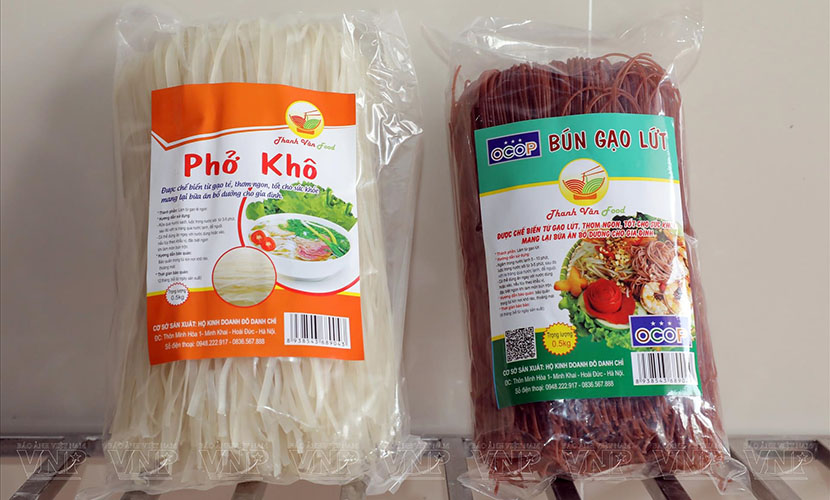
Minh Khai commune is one of the most traditional rural villages in Hanoi with the highest number of craft trades. This commune is the cradle of Vietnam’s rice vermicelli, renowned for its exceptional quality that few places can match.
From Vietnamese agricultural products such as rice and canna, local residents have created a wide variety of vermicelli and noodle products such as arrowroot vermicelli, mung bean vermicelli, dried noodles, and rice noodles. They not only conquer the domestic market but also exported abroad. Notably, many products from the Minh Khai vermicelli and noodle craft village have achieved 4-star OCOP certification.

Vietnam’s rice vermicelli
When we visited Minh Khai in 2022, what impressed us was the vibrant and lively rhythm of daily life. Across the entire village, we encountered hardworking people busy at their craft. Out in the fields at sunrise, elderly women were already diligently drying rice paper sheets on bamboo racks. Inside the village, it was easy to spot carts loaded with vermicelli heading to markets and supermarkets across Hanoi’s suburbs.
The image of hardworking villagers is one I have grown up with, as have many of my peers who were raised in this traditional craft village. A typical example is Mrs. Thuan and her husband Mr. Kiet, a family with many years of experience in Vietnam’s rice vermicelli production.
Mrs. Thuan shared that she grew up in the village and has been tied to the vermicelli craft for decades. The essence of a rural craftswoman has been part of her since childhood. She both studied and worked, gradually expanding her workshop to create high quality vermicelli for the market. Their vermicelli products under her family’s Trung Kien brand have achieved 4-star OCOP certification.
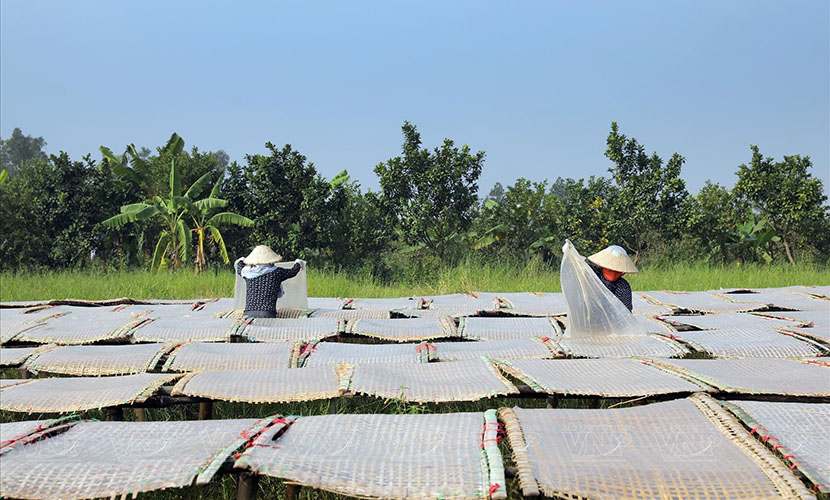
Minh Khai village of rice vermicelli
Her production facility is one of the pioneering models in the village that apply new technology in vermicelli-making process. Wit modern machinery, her facility has created a wide range of Vietnam’s rice vermicelli that ensures food safety and environmental friendliness. Trung Kien arrowroot vermicelli is famous for its natural chewiness and delicious flavor whether stir-fried or cooked in soup.
Additionally, she pays special attention for product packaging, using PE bags that meet the food safety regulations. Mrs. Thuan said, “Every Tet holiday, our vermicelli is among the most beloved gifts. Once people taste Trung Kien vermicelli, they never forget its flavor.”
Another example of successful business is Mr. Xuan’s family. His facility is recognized for their creative and breakthrough business direction with thee main product is Vietnamese galss noodles. Mr. Xuan boldly researched and developed new products such as arrowroot and mung bean vermicelli. These products had unique flavors, so they received positive feedbacks from consumers.
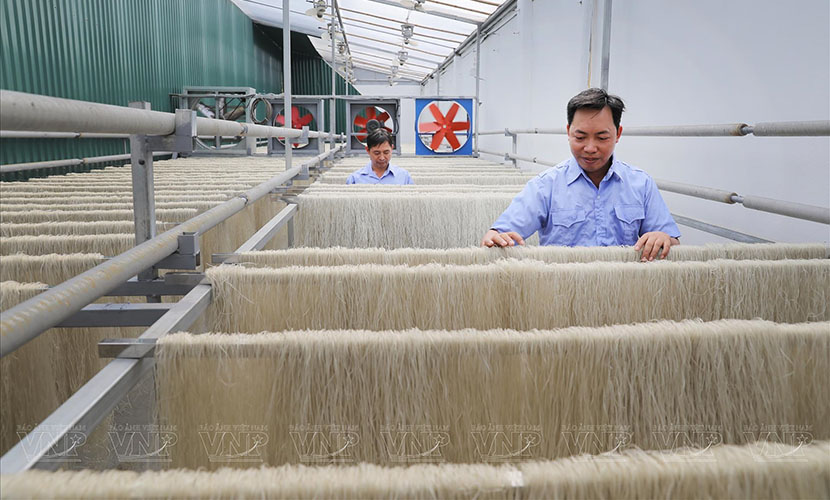
A facility of Vietnamese rice vermicelli
Each day, the Xuan Huong vermicelli facility processes more than five tons of rice. Regarding the arrowroot vermicelli, Mr. Xuan shared that his facility often receives more orders than it can fulfill. However, he insists on prioritizing quality over quantity.
He said: “We always ensure our vermicelli is fresh, delicious, clean, and made with a unique recipe no other brand can replicate.” All vermicelli and noodle products from Xuan Huong have also achieved Hanoi’s 4-star OCOP certification.
It’s difficult to list all the vermicelli-making households in Minh Khai village. Each has its own secrets that distinguish their products and establish their brand identity. However, they all share the common goals of clean production and preserving the traditions and reputation of the craft village.
Mr. Dang, Chairman of Minh Khai Committee, proudly shared: “What we value most here in Minh Khai is the people’s hard work, their commitment to traditional craft, and the pride they take in their vermicelli and noodle heritage. My generation and many others here grew up with the taste of rice and vermicelli. Many of my friends, even after becoming successful elsewhere, still return home to support local vermicelli production. A pack of noodles or vermicelli here carries the ‘memories of childhood’ for many, including myself.”
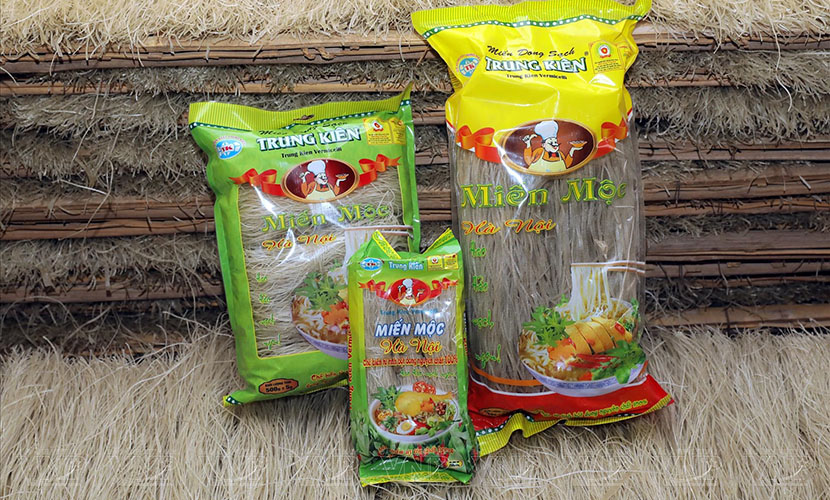
Trung Kien noodles
Today, Minh Khai Commune focuses in developing a collective brand, “Minh Khai dried noodles and pho”. It helps elevate the craft village’s products and promote them internationally. Several businesses have exported dried noodles and arrowroot vermicelli to markets such as Russia, South Korea, and Japan.
Besides arrowroot vermicelli, the village has a wide range of products. Specifically, they are vermicelli that are made from sweet potatoes, regular potatoes, brown rice, and cassava starch. As a result, they offer variety and enrich the flavors of Vietnamese cuisine.
The villagers of Minh Khai, engaged in the production of vermicelli and noodles, possess a resilience and diligence. Every day, they wake up as early as 3 a.m to soak rice and cook it. Then, they wait for the natural sunlight to dry rice paper sheets in the fields. Notably, the sunlight adds a distinct rural aroma to the finished products. Afterward, they rush back to their workshops, where the clatter of cutting machines echoes rhythmically.
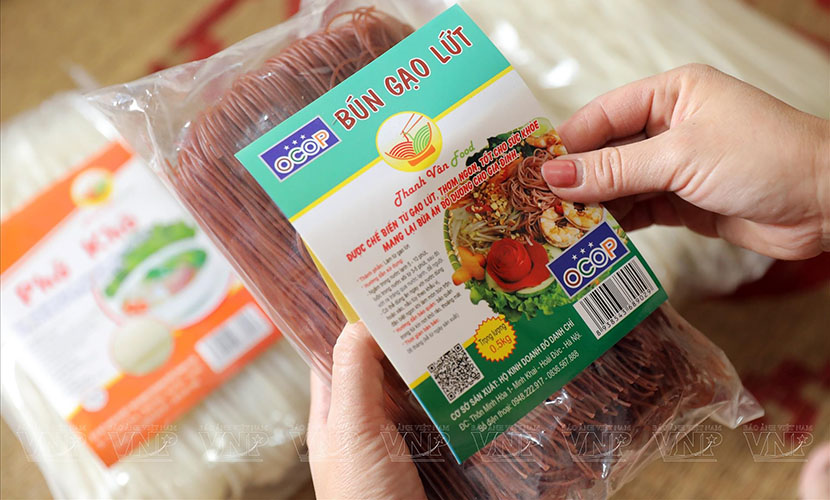
Vietnam’s brown rice vermicelli
Women and elders pack the products into bags for distribution far and wide. Perhaps this relentless hard work has finally paid off. Minh Khai’s branded noodles and vermicelli are now available throughout Vietnam and in many countries around the world. The village is also transforming, becoming more modern and prosperous. The smiles and love for their craft shine brightly in the faces of Minh Khai’s people.
Looking ahead, Minh Khai producers are uniting to strengthen the Vermicelli and Noodle production Association. Many production households will invest in science, technology, and modern equipment to increase production capacity.
The goal is to turn Minh Khai into a model of rural economic success in Hanoi’s new countryside development. Another goal is to linking craft village production with eco-tourism and cultural exploration of traditional Vietnamese trades.
Vietnamese source: https://vietnam.vnanet.vn/vietnamese/long-form/suc-song-moi-o-lang-nghe-bun-mien-minh-khai-318810.html
